Lee Huart Sea Food: Logistics and Supply Chain Management Report
VerifiedAdded on 2023/03/31
|16
|2878
|262
Report
AI Summary
This report provides a comprehensive analysis of Lee Huart Sea Food's logistics and supply chain management strategies. It examines supplier selection processes, addressing single versus multiple sourcing and utilizing the Peter Kjaljic Model for risk reduction. The report also delves into the company's ICT plan, evaluating supplier, purchaser, and independent marketplaces, alongside the use of Electronic Data Interchange (EDI). Furthermore, it explores purchasing cost analysis, comparing Total Cost Ownership (TCO) and Activity-Based Costing (ABC) methods, and recommends optimal approaches. The analysis considers the challenges and opportunities presented by e-commerce in the food supply chain, emphasizing the importance of efficient delivery processes, cost management, and reliable supplier relationships for Lee Huart's continued success in the competitive seafood market. This document is available on Desklib, a platform offering study tools and resources for students.
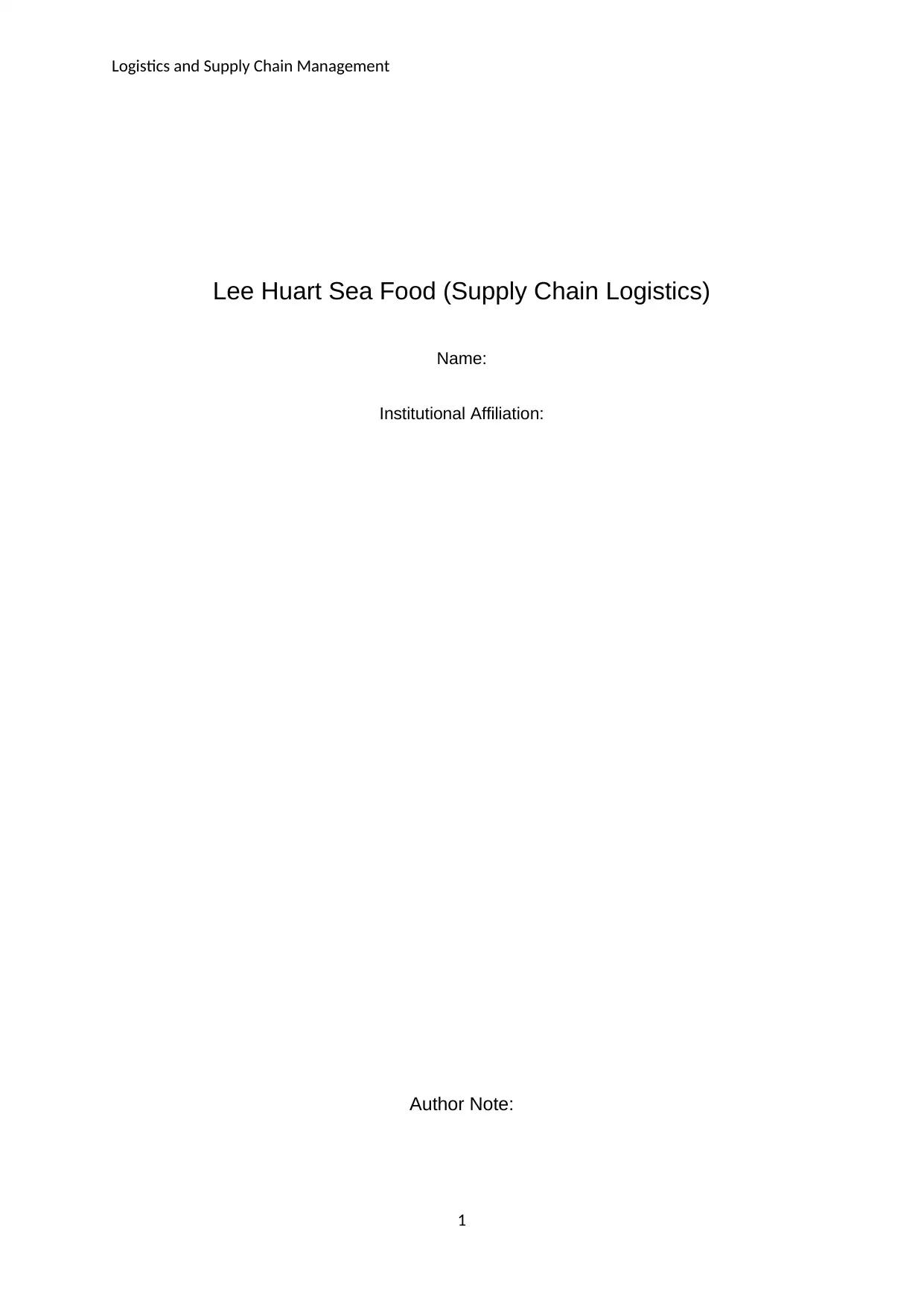
Logistics and Supply Chain Management
Lee Huart Sea Food (Supply Chain Logistics)
Name:
Institutional Affiliation:
Author Note:
1
Lee Huart Sea Food (Supply Chain Logistics)
Name:
Institutional Affiliation:
Author Note:
1
Paraphrase This Document
Need a fresh take? Get an instant paraphrase of this document with our AI Paraphraser
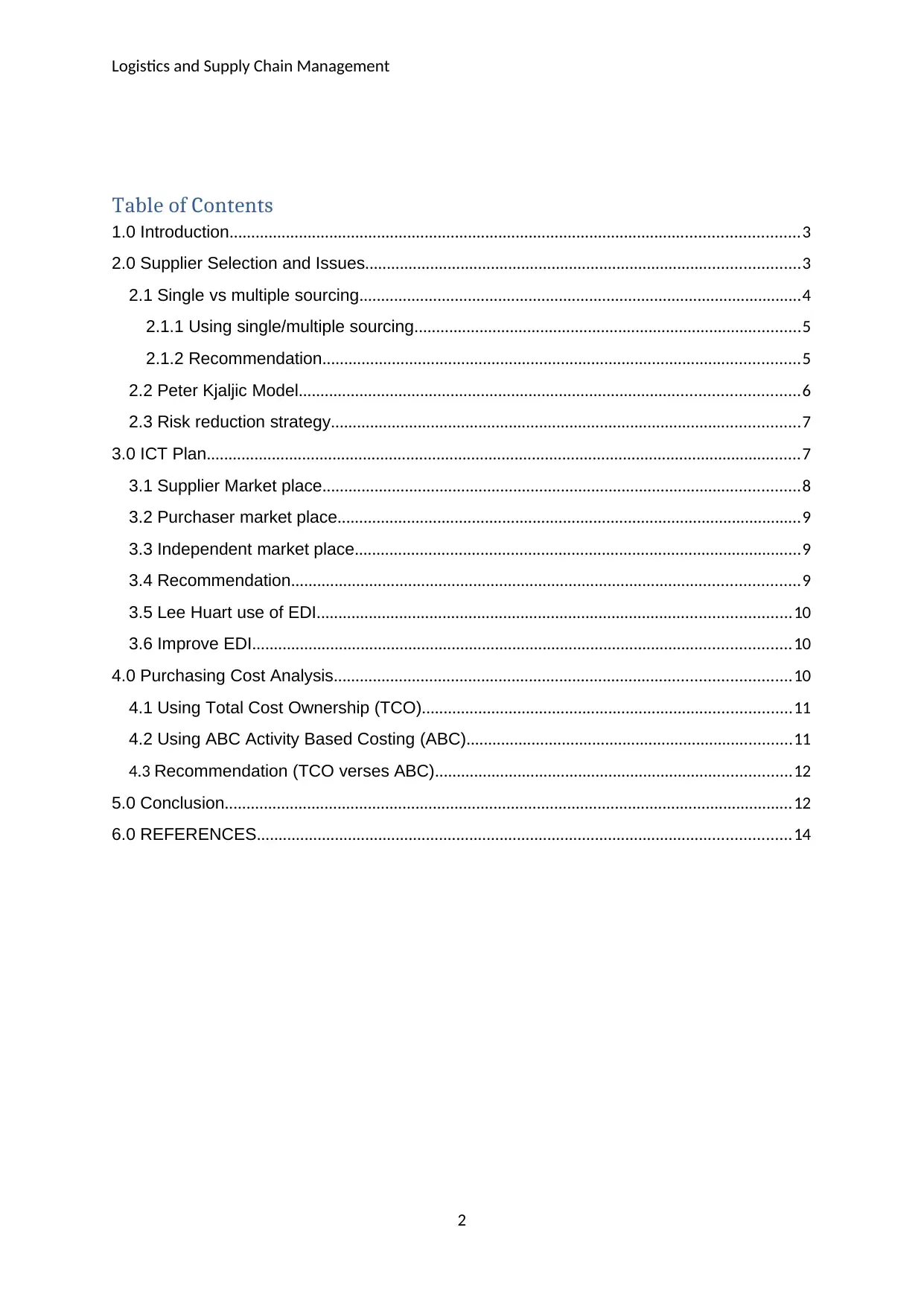
Logistics and Supply Chain Management
Table of Contents
1.0 Introduction...................................................................................................................................3
2.0 Supplier Selection and Issues....................................................................................................3
2.1 Single vs multiple sourcing......................................................................................................4
2.1.1 Using single/multiple sourcing.........................................................................................5
2.1.2 Recommendation..............................................................................................................5
2.2 Peter Kjaljic Model...................................................................................................................6
2.3 Risk reduction strategy............................................................................................................7
3.0 ICT Plan.........................................................................................................................................7
3.1 Supplier Market place..............................................................................................................8
3.2 Purchaser market place...........................................................................................................9
3.3 Independent market place.......................................................................................................9
3.4 Recommendation.....................................................................................................................9
3.5 Lee Huart use of EDI.............................................................................................................10
3.6 Improve EDI............................................................................................................................10
4.0 Purchasing Cost Analysis.........................................................................................................10
4.1 Using Total Cost Ownership (TCO).....................................................................................11
4.2 Using ABC Activity Based Costing (ABC)...........................................................................11
4.3 Recommendation (TCO verses ABC)..................................................................................12
5.0 Conclusion...................................................................................................................................12
6.0 REFERENCES...........................................................................................................................14
2
Table of Contents
1.0 Introduction...................................................................................................................................3
2.0 Supplier Selection and Issues....................................................................................................3
2.1 Single vs multiple sourcing......................................................................................................4
2.1.1 Using single/multiple sourcing.........................................................................................5
2.1.2 Recommendation..............................................................................................................5
2.2 Peter Kjaljic Model...................................................................................................................6
2.3 Risk reduction strategy............................................................................................................7
3.0 ICT Plan.........................................................................................................................................7
3.1 Supplier Market place..............................................................................................................8
3.2 Purchaser market place...........................................................................................................9
3.3 Independent market place.......................................................................................................9
3.4 Recommendation.....................................................................................................................9
3.5 Lee Huart use of EDI.............................................................................................................10
3.6 Improve EDI............................................................................................................................10
4.0 Purchasing Cost Analysis.........................................................................................................10
4.1 Using Total Cost Ownership (TCO).....................................................................................11
4.2 Using ABC Activity Based Costing (ABC)...........................................................................11
4.3 Recommendation (TCO verses ABC)..................................................................................12
5.0 Conclusion...................................................................................................................................12
6.0 REFERENCES...........................................................................................................................14
2

Logistics and Supply Chain Management
1.0 Introduction
Globally, e-commerce has benefits and challenges. Food supply chains are some of the
greatest beneficiaries of online business because of the booming sales. As more people
crave for fresh food supply, the challenge of managing logistics and distributor channels
emerges (Ruan & Shi, 2016). Lee Huart is a leading online distributor of sea food in
Singapore (Huart, 2019). Its services target wholesale sea food and frozen food distribution.
Its wide variety of supplies includes fish types, crustaceans, cephalopods and molluscs
among others. With 25 years’ experience, the company is a leading supplier of frozen foods
in the country. Focused on delivering best quality seafood, the company has a specialised
approach. Online shopping is a great platform for the company’s distribution of quality and
reliable supplies. E-commerce has opportunities for the company to make more revenue
through holiday shopping, discount offers and other marketing strategies. However, the
modern customers want convenience, speed in delivery and food safety hence the company
faces the challenge of making online shopping dependable ( (D'amico, Di Vita, Chinnici,
Pappalardo, & Pecorino, 2014)). Lee Huarts e-commerce strategy must address logistic
constraints effectively. The plan covers efficient delivery processes, lower costs and relevant
suppliers. The purpose of this essay is to analyse its supplier market, the market
competition, and strategies against impending risks. The company has a regional business
environment with opportunities but the challenge lies in the supplier selection process, use of
ICT and management of costs.
2.0 Supplier Selection and Issues
Compromising a food supply system is risky hence managers monitor all stages. Food safety
is a priority for Lee Huart because of its brand image and customer loyalty (D'amico, Di Vita,
Chinnici, Pappalardo, & Pecorino, 2014). Sourcing for the right food is critical because it
prevents unnecessary risks. A food supply chain involves stages such as:
3
1.0 Introduction
Globally, e-commerce has benefits and challenges. Food supply chains are some of the
greatest beneficiaries of online business because of the booming sales. As more people
crave for fresh food supply, the challenge of managing logistics and distributor channels
emerges (Ruan & Shi, 2016). Lee Huart is a leading online distributor of sea food in
Singapore (Huart, 2019). Its services target wholesale sea food and frozen food distribution.
Its wide variety of supplies includes fish types, crustaceans, cephalopods and molluscs
among others. With 25 years’ experience, the company is a leading supplier of frozen foods
in the country. Focused on delivering best quality seafood, the company has a specialised
approach. Online shopping is a great platform for the company’s distribution of quality and
reliable supplies. E-commerce has opportunities for the company to make more revenue
through holiday shopping, discount offers and other marketing strategies. However, the
modern customers want convenience, speed in delivery and food safety hence the company
faces the challenge of making online shopping dependable ( (D'amico, Di Vita, Chinnici,
Pappalardo, & Pecorino, 2014)). Lee Huarts e-commerce strategy must address logistic
constraints effectively. The plan covers efficient delivery processes, lower costs and relevant
suppliers. The purpose of this essay is to analyse its supplier market, the market
competition, and strategies against impending risks. The company has a regional business
environment with opportunities but the challenge lies in the supplier selection process, use of
ICT and management of costs.
2.0 Supplier Selection and Issues
Compromising a food supply system is risky hence managers monitor all stages. Food safety
is a priority for Lee Huart because of its brand image and customer loyalty (D'amico, Di Vita,
Chinnici, Pappalardo, & Pecorino, 2014). Sourcing for the right food is critical because it
prevents unnecessary risks. A food supply chain involves stages such as:
3
⊘ This is a preview!⊘
Do you want full access?
Subscribe today to unlock all pages.

Trusted by 1+ million students worldwide
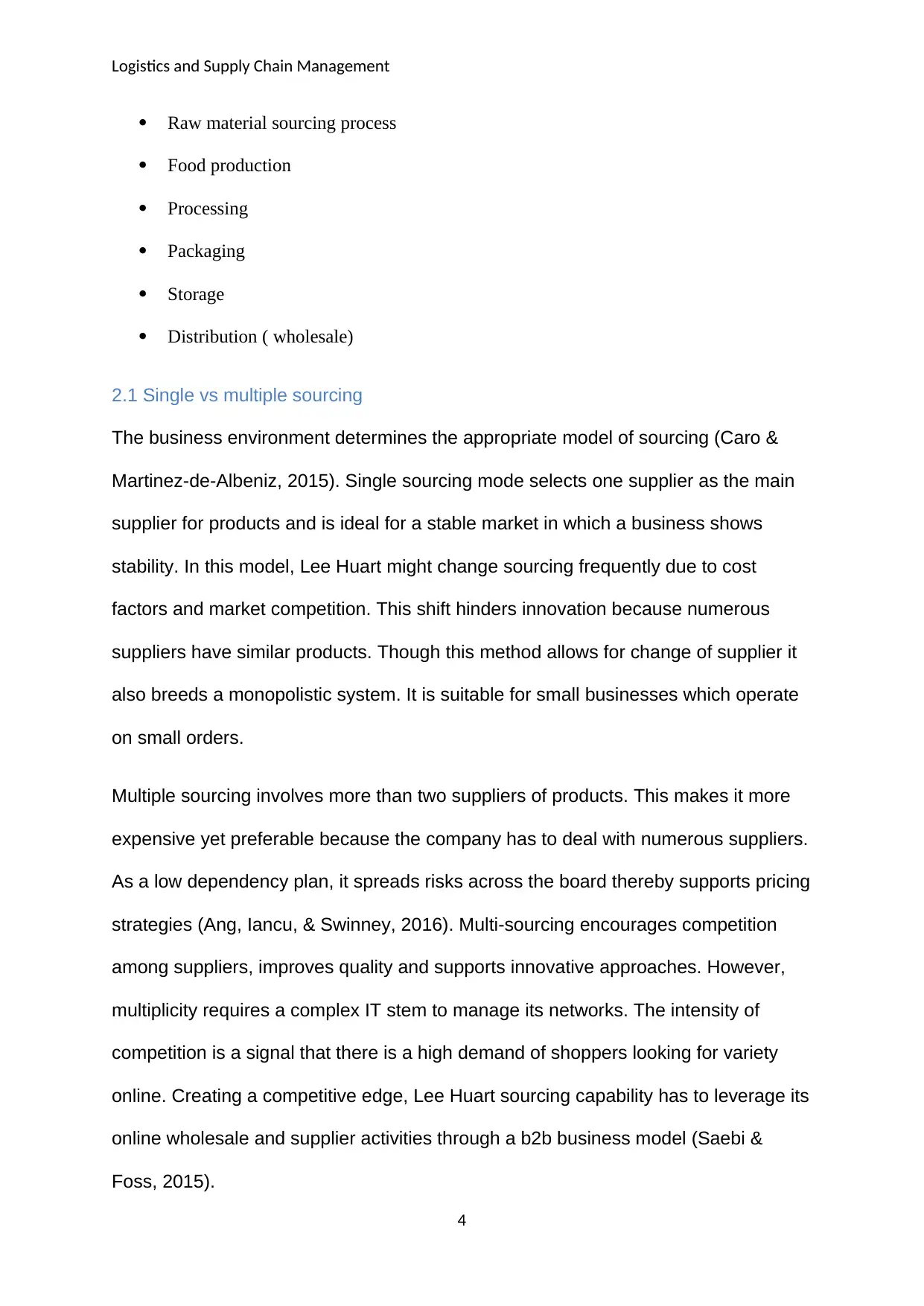
Logistics and Supply Chain Management
Raw material sourcing process
Food production
Processing
Packaging
Storage
Distribution ( wholesale)
2.1 Single vs multiple sourcing
The business environment determines the appropriate model of sourcing (Caro &
Martinez-de-Albeniz, 2015). Single sourcing mode selects one supplier as the main
supplier for products and is ideal for a stable market in which a business shows
stability. In this model, Lee Huart might change sourcing frequently due to cost
factors and market competition. This shift hinders innovation because numerous
suppliers have similar products. Though this method allows for change of supplier it
also breeds a monopolistic system. It is suitable for small businesses which operate
on small orders.
Multiple sourcing involves more than two suppliers of products. This makes it more
expensive yet preferable because the company has to deal with numerous suppliers.
As a low dependency plan, it spreads risks across the board thereby supports pricing
strategies (Ang, Iancu, & Swinney, 2016). Multi-sourcing encourages competition
among suppliers, improves quality and supports innovative approaches. However,
multiplicity requires a complex IT stem to manage its networks. The intensity of
competition is a signal that there is a high demand of shoppers looking for variety
online. Creating a competitive edge, Lee Huart sourcing capability has to leverage its
online wholesale and supplier activities through a b2b business model (Saebi &
Foss, 2015).
4
Raw material sourcing process
Food production
Processing
Packaging
Storage
Distribution ( wholesale)
2.1 Single vs multiple sourcing
The business environment determines the appropriate model of sourcing (Caro &
Martinez-de-Albeniz, 2015). Single sourcing mode selects one supplier as the main
supplier for products and is ideal for a stable market in which a business shows
stability. In this model, Lee Huart might change sourcing frequently due to cost
factors and market competition. This shift hinders innovation because numerous
suppliers have similar products. Though this method allows for change of supplier it
also breeds a monopolistic system. It is suitable for small businesses which operate
on small orders.
Multiple sourcing involves more than two suppliers of products. This makes it more
expensive yet preferable because the company has to deal with numerous suppliers.
As a low dependency plan, it spreads risks across the board thereby supports pricing
strategies (Ang, Iancu, & Swinney, 2016). Multi-sourcing encourages competition
among suppliers, improves quality and supports innovative approaches. However,
multiplicity requires a complex IT stem to manage its networks. The intensity of
competition is a signal that there is a high demand of shoppers looking for variety
online. Creating a competitive edge, Lee Huart sourcing capability has to leverage its
online wholesale and supplier activities through a b2b business model (Saebi &
Foss, 2015).
4
Paraphrase This Document
Need a fresh take? Get an instant paraphrase of this document with our AI Paraphraser
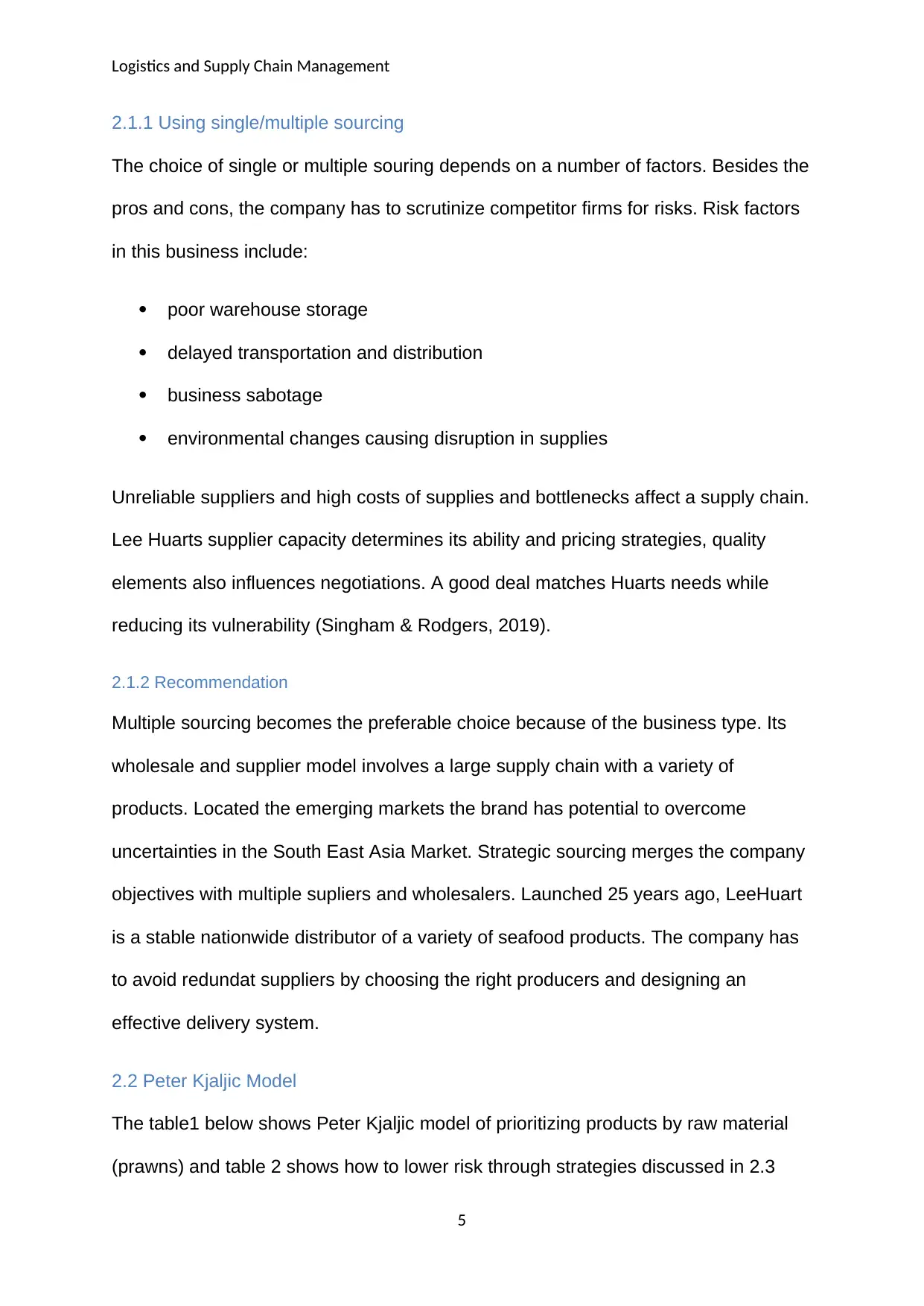
Logistics and Supply Chain Management
2.1.1 Using single/multiple sourcing
The choice of single or multiple souring depends on a number of factors. Besides the
pros and cons, the company has to scrutinize competitor firms for risks. Risk factors
in this business include:
poor warehouse storage
delayed transportation and distribution
business sabotage
environmental changes causing disruption in supplies
Unreliable suppliers and high costs of supplies and bottlenecks affect a supply chain.
Lee Huarts supplier capacity determines its ability and pricing strategies, quality
elements also influences negotiations. A good deal matches Huarts needs while
reducing its vulnerability (Singham & Rodgers, 2019).
2.1.2 Recommendation
Multiple sourcing becomes the preferable choice because of the business type. Its
wholesale and supplier model involves a large supply chain with a variety of
products. Located the emerging markets the brand has potential to overcome
uncertainties in the South East Asia Market. Strategic sourcing merges the company
objectives with multiple supliers and wholesalers. Launched 25 years ago, LeeHuart
is a stable nationwide distributor of a variety of seafood products. The company has
to avoid redundat suppliers by choosing the right producers and designing an
effective delivery system.
2.2 Peter Kjaljic Model
The table1 below shows Peter Kjaljic model of prioritizing products by raw material
(prawns) and table 2 shows how to lower risk through strategies discussed in 2.3
5
2.1.1 Using single/multiple sourcing
The choice of single or multiple souring depends on a number of factors. Besides the
pros and cons, the company has to scrutinize competitor firms for risks. Risk factors
in this business include:
poor warehouse storage
delayed transportation and distribution
business sabotage
environmental changes causing disruption in supplies
Unreliable suppliers and high costs of supplies and bottlenecks affect a supply chain.
Lee Huarts supplier capacity determines its ability and pricing strategies, quality
elements also influences negotiations. A good deal matches Huarts needs while
reducing its vulnerability (Singham & Rodgers, 2019).
2.1.2 Recommendation
Multiple sourcing becomes the preferable choice because of the business type. Its
wholesale and supplier model involves a large supply chain with a variety of
products. Located the emerging markets the brand has potential to overcome
uncertainties in the South East Asia Market. Strategic sourcing merges the company
objectives with multiple supliers and wholesalers. Launched 25 years ago, LeeHuart
is a stable nationwide distributor of a variety of seafood products. The company has
to avoid redundat suppliers by choosing the right producers and designing an
effective delivery system.
2.2 Peter Kjaljic Model
The table1 below shows Peter Kjaljic model of prioritizing products by raw material
(prawns) and table 2 shows how to lower risk through strategies discussed in 2.3
5
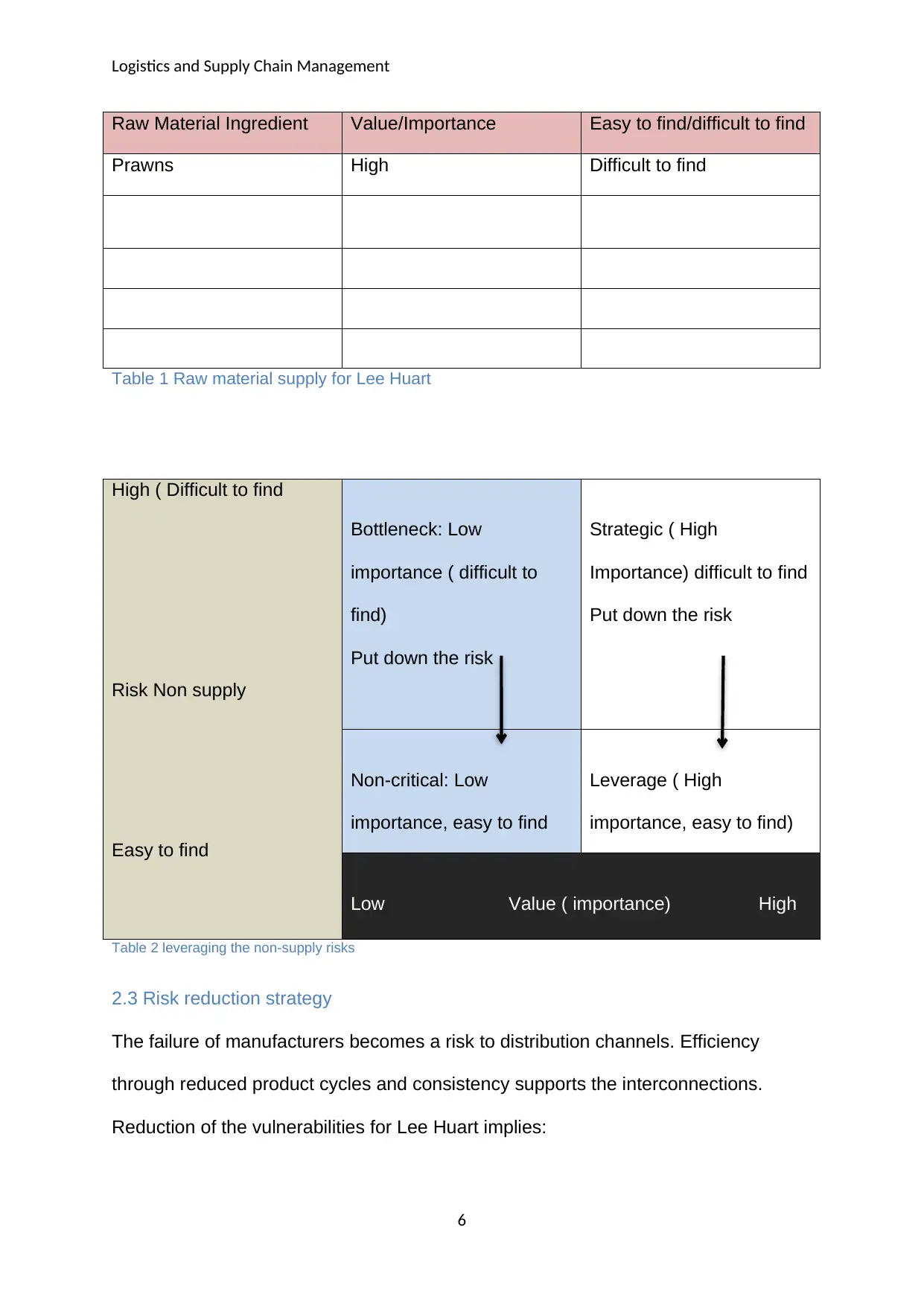
Logistics and Supply Chain Management
Raw Material Ingredient Value/Importance Easy to find/difficult to find
Prawns High Difficult to find
Table 1 Raw material supply for Lee Huart
High ( Difficult to find
Risk Non supply
Easy to find
Bottleneck: Low
importance ( difficult to
find)
Put down the risk
Strategic ( High
Importance) difficult to find
Put down the risk
Non-critical: Low
importance, easy to find
Leverage ( High
importance, easy to find)
Low Value ( importance) High
Table 2 leveraging the non-supply risks
2.3 Risk reduction strategy
The failure of manufacturers becomes a risk to distribution channels. Efficiency
through reduced product cycles and consistency supports the interconnections.
Reduction of the vulnerabilities for Lee Huart implies:
6
Raw Material Ingredient Value/Importance Easy to find/difficult to find
Prawns High Difficult to find
Table 1 Raw material supply for Lee Huart
High ( Difficult to find
Risk Non supply
Easy to find
Bottleneck: Low
importance ( difficult to
find)
Put down the risk
Strategic ( High
Importance) difficult to find
Put down the risk
Non-critical: Low
importance, easy to find
Leverage ( High
importance, easy to find)
Low Value ( importance) High
Table 2 leveraging the non-supply risks
2.3 Risk reduction strategy
The failure of manufacturers becomes a risk to distribution channels. Efficiency
through reduced product cycles and consistency supports the interconnections.
Reduction of the vulnerabilities for Lee Huart implies:
6
⊘ This is a preview!⊘
Do you want full access?
Subscribe today to unlock all pages.

Trusted by 1+ million students worldwide
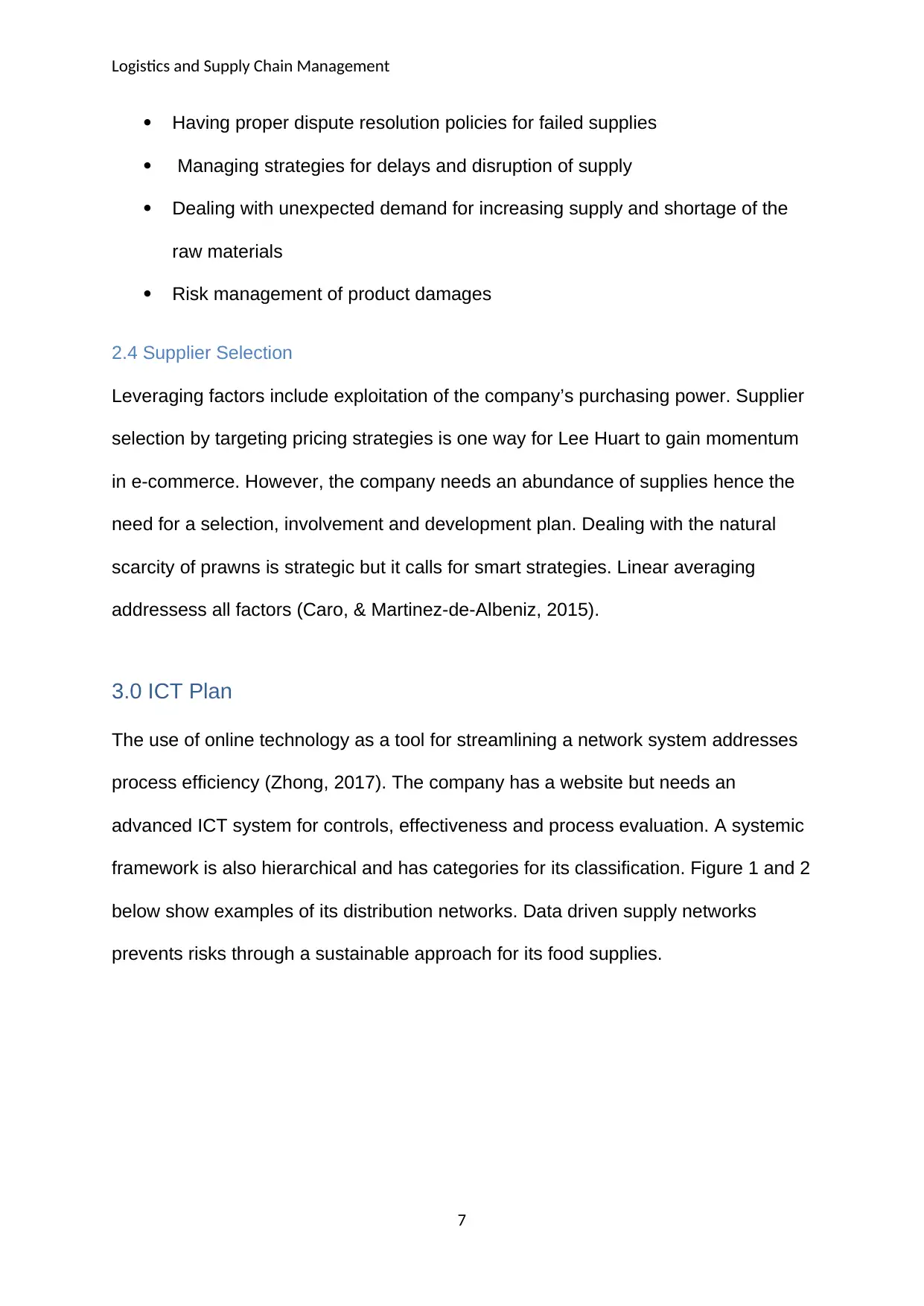
Logistics and Supply Chain Management
Having proper dispute resolution policies for failed supplies
Managing strategies for delays and disruption of supply
Dealing with unexpected demand for increasing supply and shortage of the
raw materials
Risk management of product damages
2.4 Supplier Selection
Leveraging factors include exploitation of the company’s purchasing power. Supplier
selection by targeting pricing strategies is one way for Lee Huart to gain momentum
in e-commerce. However, the company needs an abundance of supplies hence the
need for a selection, involvement and development plan. Dealing with the natural
scarcity of prawns is strategic but it calls for smart strategies. Linear averaging
addressess all factors (Caro, & Martinez-de-Albeniz, 2015).
3.0 ICT Plan
The use of online technology as a tool for streamlining a network system addresses
process efficiency (Zhong, 2017). The company has a website but needs an
advanced ICT system for controls, effectiveness and process evaluation. A systemic
framework is also hierarchical and has categories for its classification. Figure 1 and 2
below show examples of its distribution networks. Data driven supply networks
prevents risks through a sustainable approach for its food supplies.
7
Having proper dispute resolution policies for failed supplies
Managing strategies for delays and disruption of supply
Dealing with unexpected demand for increasing supply and shortage of the
raw materials
Risk management of product damages
2.4 Supplier Selection
Leveraging factors include exploitation of the company’s purchasing power. Supplier
selection by targeting pricing strategies is one way for Lee Huart to gain momentum
in e-commerce. However, the company needs an abundance of supplies hence the
need for a selection, involvement and development plan. Dealing with the natural
scarcity of prawns is strategic but it calls for smart strategies. Linear averaging
addressess all factors (Caro, & Martinez-de-Albeniz, 2015).
3.0 ICT Plan
The use of online technology as a tool for streamlining a network system addresses
process efficiency (Zhong, 2017). The company has a website but needs an
advanced ICT system for controls, effectiveness and process evaluation. A systemic
framework is also hierarchical and has categories for its classification. Figure 1 and 2
below show examples of its distribution networks. Data driven supply networks
prevents risks through a sustainable approach for its food supplies.
7
Paraphrase This Document
Need a fresh take? Get an instant paraphrase of this document with our AI Paraphraser
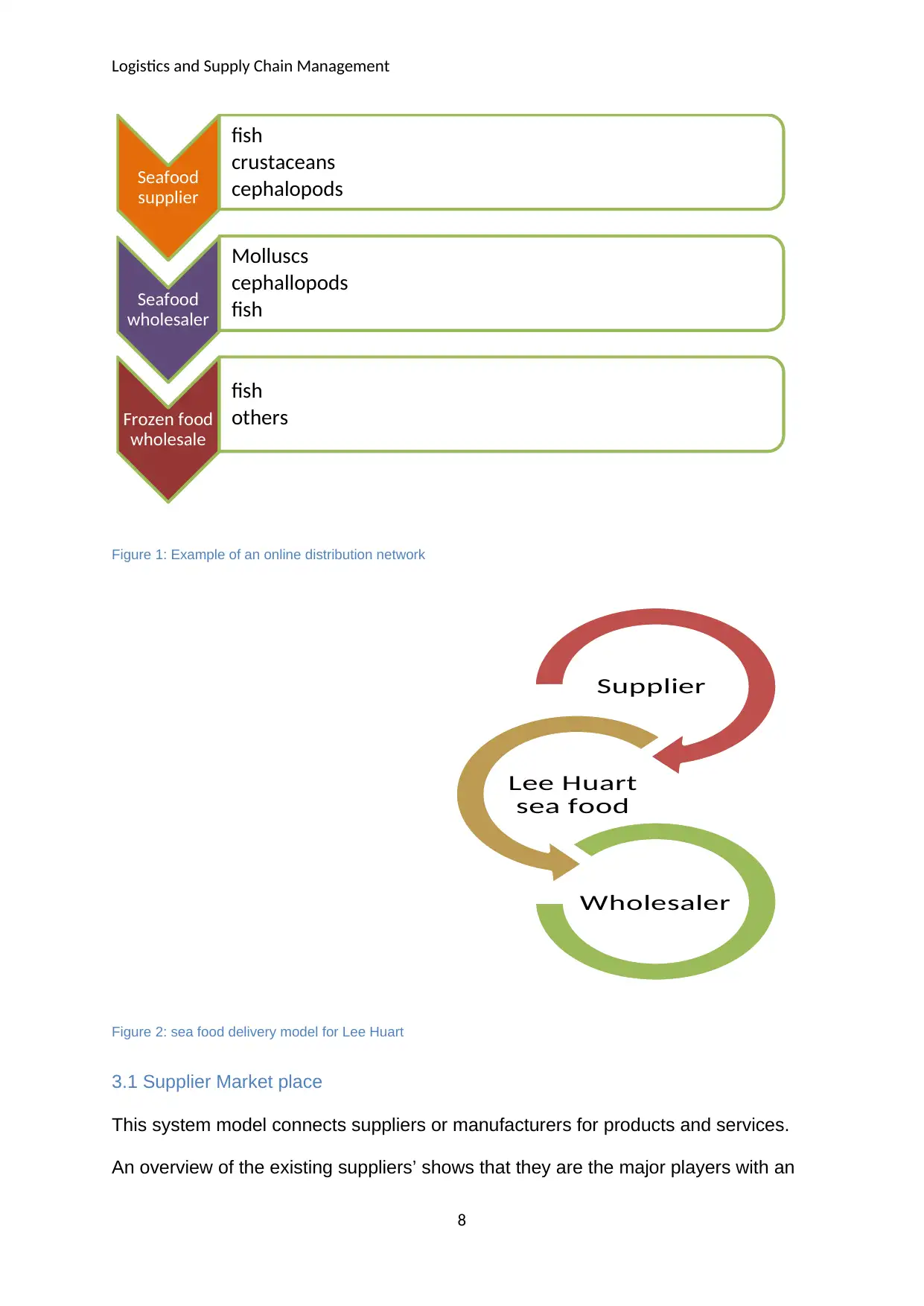
Logistics and Supply Chain Management
Figure 1: Example of an online distribution network
Figure 2: sea food delivery model for Lee Huart
3.1 Supplier Market place
This system model connects suppliers or manufacturers for products and services.
An overview of the existing suppliers’ shows that they are the major players with an
8
Seafood
supplier
fish
crustaceans
cephalopods
Seafood
wholesaler
Molluscs
cephallopods
fish
Frozen food
wholesale
fish
others
Supplier
Lee Huart
sea food
Wholesaler
Figure 1: Example of an online distribution network
Figure 2: sea food delivery model for Lee Huart
3.1 Supplier Market place
This system model connects suppliers or manufacturers for products and services.
An overview of the existing suppliers’ shows that they are the major players with an
8
Seafood
supplier
fish
crustaceans
cephalopods
Seafood
wholesaler
Molluscs
cephallopods
fish
Frozen food
wholesale
fish
others
Supplier
Lee Huart
sea food
Wholesaler
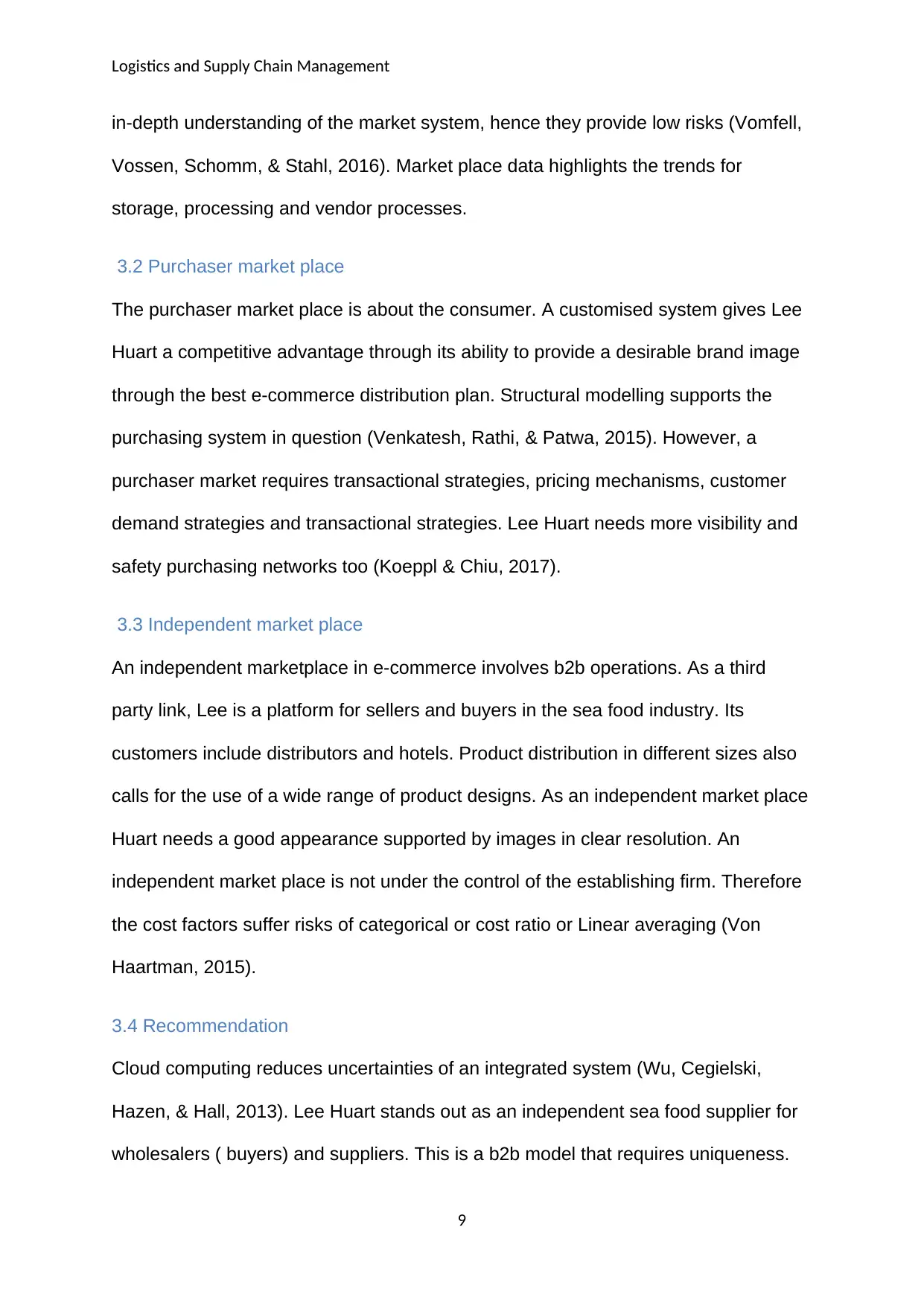
Logistics and Supply Chain Management
in-depth understanding of the market system, hence they provide low risks (Vomfell,
Vossen, Schomm, & Stahl, 2016). Market place data highlights the trends for
storage, processing and vendor processes.
3.2 Purchaser market place
The purchaser market place is about the consumer. A customised system gives Lee
Huart a competitive advantage through its ability to provide a desirable brand image
through the best e-commerce distribution plan. Structural modelling supports the
purchasing system in question (Venkatesh, Rathi, & Patwa, 2015). However, a
purchaser market requires transactional strategies, pricing mechanisms, customer
demand strategies and transactional strategies. Lee Huart needs more visibility and
safety purchasing networks too (Koeppl & Chiu, 2017).
3.3 Independent market place
An independent marketplace in e-commerce involves b2b operations. As a third
party link, Lee is a platform for sellers and buyers in the sea food industry. Its
customers include distributors and hotels. Product distribution in different sizes also
calls for the use of a wide range of product designs. As an independent market place
Huart needs a good appearance supported by images in clear resolution. An
independent market place is not under the control of the establishing firm. Therefore
the cost factors suffer risks of categorical or cost ratio or Linear averaging (Von
Haartman, 2015).
3.4 Recommendation
Cloud computing reduces uncertainties of an integrated system (Wu, Cegielski,
Hazen, & Hall, 2013). Lee Huart stands out as an independent sea food supplier for
wholesalers ( buyers) and suppliers. This is a b2b model that requires uniqueness.
9
in-depth understanding of the market system, hence they provide low risks (Vomfell,
Vossen, Schomm, & Stahl, 2016). Market place data highlights the trends for
storage, processing and vendor processes.
3.2 Purchaser market place
The purchaser market place is about the consumer. A customised system gives Lee
Huart a competitive advantage through its ability to provide a desirable brand image
through the best e-commerce distribution plan. Structural modelling supports the
purchasing system in question (Venkatesh, Rathi, & Patwa, 2015). However, a
purchaser market requires transactional strategies, pricing mechanisms, customer
demand strategies and transactional strategies. Lee Huart needs more visibility and
safety purchasing networks too (Koeppl & Chiu, 2017).
3.3 Independent market place
An independent marketplace in e-commerce involves b2b operations. As a third
party link, Lee is a platform for sellers and buyers in the sea food industry. Its
customers include distributors and hotels. Product distribution in different sizes also
calls for the use of a wide range of product designs. As an independent market place
Huart needs a good appearance supported by images in clear resolution. An
independent market place is not under the control of the establishing firm. Therefore
the cost factors suffer risks of categorical or cost ratio or Linear averaging (Von
Haartman, 2015).
3.4 Recommendation
Cloud computing reduces uncertainties of an integrated system (Wu, Cegielski,
Hazen, & Hall, 2013). Lee Huart stands out as an independent sea food supplier for
wholesalers ( buyers) and suppliers. This is a b2b model that requires uniqueness.
9
⊘ This is a preview!⊘
Do you want full access?
Subscribe today to unlock all pages.

Trusted by 1+ million students worldwide

Logistics and Supply Chain Management
This company would use a supplier market place plan because it targets producers
from the wider audience. It also needs a purchaser oriented marketplace design for
pricing and special offers. It also serves as an independent link connecting buyers
and suppliers. An integration of systems gives detailed descriptions, a filtering
system and catalogues for showcasing products. Lee Huart needs to invest in data
management software apps.
3.5 Lee Huart use of EDI
Lee Huart uses Electronic data interchange (EDI) for its operations because it is a
national entity with suppliers oversees. Technology is critical in e-commerce for
quick and efficient transactions (Wei, et al., 2018; Koeppl & Chiu, 2017). EDI has tools
for web analysis on the business perfomance and risk management strategies. This
system supports Lee Huarts growth to become a cross border operation. It supports
managed costs and relationships. It is ideal for collaborative supply chains, control
processess and shipment activities.
3.6 Improve EDI
Although EDI increases online engagement, Lee Huart customers also need safety.
EDI supports the complex supply system but an effective synchronization is
necessary. This measure prevents discrepancies and unauthorised access or
unplanned deliveries. Lee Huart needs a standard documentation process, and an
effective stakeholder data management system (Ang, Iancu, & Swinney, 2016).
4.0 Purchasing Cost Analysis
The supply and demand law in e-commerce is an interconnected chain (Venkatesh, Rathi, &
Patwa, 2015). Lee Huart supplies large volumes of sea food products depending on the
customer demand. The management of logistics in a complex system is necessary for
10
This company would use a supplier market place plan because it targets producers
from the wider audience. It also needs a purchaser oriented marketplace design for
pricing and special offers. It also serves as an independent link connecting buyers
and suppliers. An integration of systems gives detailed descriptions, a filtering
system and catalogues for showcasing products. Lee Huart needs to invest in data
management software apps.
3.5 Lee Huart use of EDI
Lee Huart uses Electronic data interchange (EDI) for its operations because it is a
national entity with suppliers oversees. Technology is critical in e-commerce for
quick and efficient transactions (Wei, et al., 2018; Koeppl & Chiu, 2017). EDI has tools
for web analysis on the business perfomance and risk management strategies. This
system supports Lee Huarts growth to become a cross border operation. It supports
managed costs and relationships. It is ideal for collaborative supply chains, control
processess and shipment activities.
3.6 Improve EDI
Although EDI increases online engagement, Lee Huart customers also need safety.
EDI supports the complex supply system but an effective synchronization is
necessary. This measure prevents discrepancies and unauthorised access or
unplanned deliveries. Lee Huart needs a standard documentation process, and an
effective stakeholder data management system (Ang, Iancu, & Swinney, 2016).
4.0 Purchasing Cost Analysis
The supply and demand law in e-commerce is an interconnected chain (Venkatesh, Rathi, &
Patwa, 2015). Lee Huart supplies large volumes of sea food products depending on the
customer demand. The management of logistics in a complex system is necessary for
10
Paraphrase This Document
Need a fresh take? Get an instant paraphrase of this document with our AI Paraphraser

Logistics and Supply Chain Management
regular distribution of products with different sizes, design, colour and prices. The decision
making process looks at value for money, best products and customer needs for a risk free
mode of sourcing (Christopher, 2016). There is need to control both the external and internal
risks. Mitigating the risks starts with understanding the customer demand. Managing
finances through the supplier and sale distribution channels is critical. The cost of supplies
tends to become higher when the supply exceeds demand. In this case the price would fall.
Consequently when the demand goes higher than supplies, the price rises. Equilibrium in e-
commerce payment systems follows the same law of market supply and demand for a
balance. Striking equilibrium through an effective monetary system is important for online
transactions.
4.1 Using Total Cost Ownership (TCO)
Full cost accounting is a costing approach that considers the end-to end variable
costs of a process. An example is the TCO in which buyers and owners estimate
costs via direct and indirect cost analysis. In manufacturing, it accounts for the full
cycle including the production times and distribution costs. Lee Huarts cost of doing
business involves an in-depth accounting of the production and distribution costs.
The purchasing costs cover external side effects that could have a positive or
negative impact on the business. Lee Huart analyses its operational costs with
details such as electricity, food testing costs, ICT; and delivery time management
under TCO. Long term costs, risk management plan and systems upgrade also
feature (Hsu, Ray, & Li-Hsie, 2014). Therefore TCO gives it a broader picture for
concrete and long term decisions.
4.2 Using ABC Activity Based Costing (ABC)
The ABC approach weighs the cost of activities for actual variable benefits of each.
Targeting more of the overhead costs, it traces the resource factors for indirect costs
11
regular distribution of products with different sizes, design, colour and prices. The decision
making process looks at value for money, best products and customer needs for a risk free
mode of sourcing (Christopher, 2016). There is need to control both the external and internal
risks. Mitigating the risks starts with understanding the customer demand. Managing
finances through the supplier and sale distribution channels is critical. The cost of supplies
tends to become higher when the supply exceeds demand. In this case the price would fall.
Consequently when the demand goes higher than supplies, the price rises. Equilibrium in e-
commerce payment systems follows the same law of market supply and demand for a
balance. Striking equilibrium through an effective monetary system is important for online
transactions.
4.1 Using Total Cost Ownership (TCO)
Full cost accounting is a costing approach that considers the end-to end variable
costs of a process. An example is the TCO in which buyers and owners estimate
costs via direct and indirect cost analysis. In manufacturing, it accounts for the full
cycle including the production times and distribution costs. Lee Huarts cost of doing
business involves an in-depth accounting of the production and distribution costs.
The purchasing costs cover external side effects that could have a positive or
negative impact on the business. Lee Huart analyses its operational costs with
details such as electricity, food testing costs, ICT; and delivery time management
under TCO. Long term costs, risk management plan and systems upgrade also
feature (Hsu, Ray, & Li-Hsie, 2014). Therefore TCO gives it a broader picture for
concrete and long term decisions.
4.2 Using ABC Activity Based Costing (ABC)
The ABC approach weighs the cost of activities for actual variable benefits of each.
Targeting more of the overhead costs, it traces the resource factors for indirect costs
11

Logistics and Supply Chain Management
(Christopher, 2016). This plan allows Lee Huart to deal with unprofitability while
lowering overpriced goods. It is also effective in eliminating ineffective processes for
better yields. Although its activity based approach recognises manufacturers and
relationship costs, it fails to cover operational costs effectively. It traces costs
through transactions and duration based activities thereby preventing an
accumulation of costs. In the Lee Huarts case, this plan would transfer indirect costs
from high volume to low volume products.
4.3 Recommendation (ABC)
An analysis of the ABC (contemporary) verses TCO (traditional) costing reveals the
suitability of ABC approaches for Lee Huart as a growing supply chain. Although
both methods account for indirect costs, Lee Huart needs an accurate analysis of its
indirect costs. In e-commerce a time driven system measures the long term and
localized costs of a service (Laviana, et al., 2016). This is what Lee Haurt requires
because of its overseas suppliers. ABC may cost more but it is more accurate for a
supplier with multiple products. It also supports the environmental costs which are
necessary in a contemporary supply chain system.
5.0 Conclusion
Lee Huart is a leading e-commerce supplier of seafood products in Singapore. With
numerous buyers in the wholesale business the company needs constant supplies.
It’s wide range of products calls for an efficient and reliable e-commerce system.
Dealing with suppliers across the globe, the brand needs strategies that contain
risks. A food supply chain network is delicate. Supplier selection, cost analysis and
technology input support lee Huart’s logistics. E-commerce retail suppliers thrive
through strategic implementation of best practices. One of this is strategic
12
(Christopher, 2016). This plan allows Lee Huart to deal with unprofitability while
lowering overpriced goods. It is also effective in eliminating ineffective processes for
better yields. Although its activity based approach recognises manufacturers and
relationship costs, it fails to cover operational costs effectively. It traces costs
through transactions and duration based activities thereby preventing an
accumulation of costs. In the Lee Huarts case, this plan would transfer indirect costs
from high volume to low volume products.
4.3 Recommendation (ABC)
An analysis of the ABC (contemporary) verses TCO (traditional) costing reveals the
suitability of ABC approaches for Lee Huart as a growing supply chain. Although
both methods account for indirect costs, Lee Huart needs an accurate analysis of its
indirect costs. In e-commerce a time driven system measures the long term and
localized costs of a service (Laviana, et al., 2016). This is what Lee Haurt requires
because of its overseas suppliers. ABC may cost more but it is more accurate for a
supplier with multiple products. It also supports the environmental costs which are
necessary in a contemporary supply chain system.
5.0 Conclusion
Lee Huart is a leading e-commerce supplier of seafood products in Singapore. With
numerous buyers in the wholesale business the company needs constant supplies.
It’s wide range of products calls for an efficient and reliable e-commerce system.
Dealing with suppliers across the globe, the brand needs strategies that contain
risks. A food supply chain network is delicate. Supplier selection, cost analysis and
technology input support lee Huart’s logistics. E-commerce retail suppliers thrive
through strategic implementation of best practices. One of this is strategic
12
⊘ This is a preview!⊘
Do you want full access?
Subscribe today to unlock all pages.

Trusted by 1+ million students worldwide
1 out of 16
Your All-in-One AI-Powered Toolkit for Academic Success.
+13062052269
info@desklib.com
Available 24*7 on WhatsApp / Email
![[object Object]](/_next/static/media/star-bottom.7253800d.svg)
Unlock your academic potential
Copyright © 2020–2026 A2Z Services. All Rights Reserved. Developed and managed by ZUCOL.
